The Missing
On 14th October 1920, two judicial officers drove out of Mullingar, Co. Westmeath, in the direction of the town of Castlepollard. There, they were to supervise the Petty Sessions at the Crown Court. They never made it. Somewhere along the way, Maxwell Moore, Resident Magistrate, and G.R. Hyde, Justice of the Peace, were abducted by armed men. Police and soldiers from the nearby British garrison scoured the area, only to find no trace of the vanished officials.
That telegraph wires between Mullingar and Castlepollard had been cut suggested a level of planning. Although the newspapers at the time did not state as such, no one was in any doubt that this was the work of the Irish Republican Army (IRA) as part of its guerrilla war against the British state in Ireland.[1]
In response, Crown forces would conduct a search operation throughout the countryside that had grievous consequences for the local IRA. The Mullingar area had been relatively untouched by the conflict that was affecting the country. The kidnapping of the two magistrates would ensure that that no longer held true.

The IRA
The Mullingar IRA had always struggled to define itself amongst the rest of the organisation. There was even uncertainty as to when it became a brigade in its own right instead of than a battalion affixed to another – a couple of sources have it happening after the Conscription Crisis in early 1919, with another believing it as being sometime in 1920.[2]
Before, the Mullingar Volunteers had been attached to the North Offaly Brigade and then to the Athlone one. They were, according to the Athlone IRA O/C, confused into thinking they became a brigade sooner than they did due to an agreement between him and GHQ in mid-1920 that the Mullingar battalion would receive its orders directly from Dublin rather than Athlone as before.[3]
Whatever its exact status, the Mullingar IRA suffered from the same problems afflicting many other units throughout the country during the War of Independence: a scarcity of weapons and the lack of opportunities with which to use the few guns they did possess. But by October 1920, the Mullingar leadership had seen a chance to rectify the latter failing.
The Plan
Returning to the Mullingar IRA at this time was James Maguire. He had been hiding out in Liverpool to escape a murder charge of a Royal Irish Constabulary (RIC) policeman, something he denied any knowledge of and which was probably true considering how he continued to deny it even years later.
Upon his arrival back, Maguire was invited to a couple of meetings with Mullingar IRA officers about possible operations. Maguire was surprised that these senior men were willing to talk so openly with him despite his lack of a rank. He suspected that they had erroneously assumed he had picked up some sort of military experience while in Liverpool, although he did not disabuse them of the notion.
In any case, Maguire was eager to assist in any way he could. It was when Maguire was talking to Patrick McCabe, the O/C of the Castlepollard Company (there being four such companies altogether in the Mullingar IRA) that the germ of the kidnap plan was formed.
This plan dovetailed neatly into the persistent campaign by the Volunteers to undermine the Crown courts. For the most part this had been a success, with local people opting for the underground Sinn Féin ones despite their proscribed status. The Crown courts found themselves isolated, frustrated and starved of manpower.
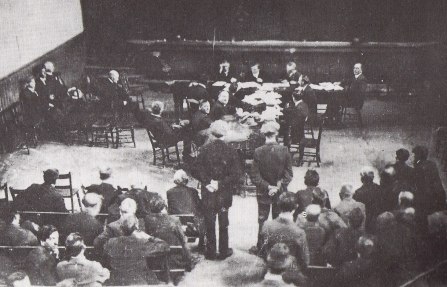
On the 20th of the same month as the kidnappings, the Mullingar Petty Sessions found that of the twenty-five people summoned for grand jury duty, only eleven had shown up, and two of those would not even answer to confirm their names. The court session was adjourned due to the insufficient numbers, an act of surrender worrying enough to be included in the monthly RIC report to Dublin Castle.[4]
This malaise reached the level of the Crown magistrates, many of whom stopped attending their own courts. That Moore persevered in being the stubborn exception, despite several warnings, alone made him a target.
McCabe explained to Maguire another, more immediate reason: fifteen of the Volunteers in his company had been brought to court by the RIC on trivial charges, such as a lack of light on their bicycles. Moore was set to hear these cases in Castlepollard. Kidnapping him would not only be a blow against the British system, it would also save McCabe’s men from having to face an unfriendly court.

Maguire forwarded the idea to John Macken, the Mullingar O/C, and they agreed to seize Maxwell as suggested. Although Maguire accredits McCabe with originating the idea, McCabe made no mention of doing such a thing in his Bureau of Military History (BMH) Statement. When McCabe came round to describing the incident, it was as someone who had had nothing to do with it. Either Maguire had misremembered the conversation or McCabe had forgotten had forgotten all about it by 1956, when he composed his Statement.[5]
The Preparation
It was decided to waylay Moore as he neared Castlepollard, where the road ran to a steep incline that would force his car to slow. Maguire and Macken agreed between them to bring a few men each to assist. One of McCabe’s choices was the man assigned to drive the car, clearly a specialised skill at the time.
On the appointed day, the selected ambush party arrived at the site on bicycles – the IRA vehicle of choice in the War – which were then dumped. Two hills on either side of the road formed a valley and a sentry was assigned on each to keep watch for the magistrate’s car. Brushwood along the road provided cover for the rest.
It had been arranged that one of the sentries would warn the others with a white flag if the car came with an escort, in which case the operation would be aborted and the target allowed to continue on unmolested.
After several cars had passed by, oblivious to the posse lurking in the undergrowth, a signal from one of the sentries alerted his comrades that their quarry was approaching. A ladder was thrown across the road with a couple of large stones on either end.
The Kidnap
When the lone car came to a halt, the Volunteers were surprised to see that there was a second man in the car with Moore. They had not been expecting G.R. Hyde as well. Deciding not to look a gift-horse in the mouth, the ambushers surrounded the car and demanded the occupants step out.

Newspaper reports were to describe the kidnappers as an ‘armed party’ but only two of them had a weapon – Macken with a .32 revolver and Maguire holding a .45 Webley – due to the paucity of guns in the Mullingar IRA. The kidnappers had come prepared in case their targets were armed, though it turned out that they were not.
The Volunteers put a few stones behind the back wheels of the car to prevent it rolling downhill. Their protests ignored, Moore and Hyde were forced into the backseat where they were bound and blindfolded. With a theatrical touch, women’s hats were draped over their heads in case police or military were encountered en route, though it is debatable as to how well such disguises would have worked.
In any case, the kidnappers had a more immediate concern: starting the car. The designated driver was called from further down the road where he had been waiting. As he was already known to the victims, presumably from an earlier court session, it was feared that they would have been able to identify him.
The Getaway
The driver fumbled about, trying to start the car but the vehicle was of an unfamiliar make and its controls were unknown to him. With the fear of being stranded on the road, Maguire threatened Moore at gunpoint to tell the driver how to start the engine. Determined to be as unhelpful as possible, Moore, a veteran of the British army, would only tell them nothing more than that the starter was on the steering wheel.
Eventually the car was started. Maguire and his hijackers drove their new-found companions away while McCabe’s made themselves scarce on their bicycles. The car was later found in a wrecked state, the official report attributing the damage to “unskilled driving.”
While under cross-examination in April 1921, in his efforts at compensation for the loss of his vehicle, Moore was scathing in his description of the ineptitude displayed by his abductors:
Solicitor: Had you to show them [how to drive]?
Moore: Yes; I and Mr Hyde were blindfolded and I was compelled to instruct the driver how to drive the car…the man knew nothing about driving the car, and when he put off the clutch it leaped and bounded along the road.
Solicitor: It was full of life.
Moore: Yes, full of life (laughter).[6]
The Promotions
Still blindfolded, the two prisoners were driven to the Ballymanus area, their captors careful to use byroads to better avoid detection. The car arrived at the end of a country lane by Lough Sheelin, where the two prisoners were lodged in a disused farmhouse, under guard by the local Volunteers.
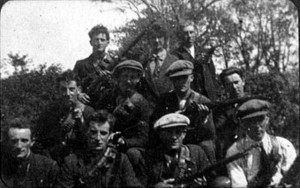
The operation was to garner promotions in the Mullingar IRA, whether wanted or not. Shortly after the kidnapping, a pair of officers arrived from GHQ in Dublin for a meeting in Mullingar. As Maguire had made no report of the kidnapping to anyone, he was unsure as to whether these out-of-towners knew about it. Maguire did not attend the meeting but, afterwards, saw McCabe talking to the GHQ men and showing them a written report of the operation. Seeing Maguire, McCabe waved him over and announced him as: “The man responsible. That’s the man who captured them.” Maguire was the hero of the hour.
The two GHQ officers then announced some unexpected news. The Mullingar O/C was stepping down, leaving his post vacant. The officers told McCabe that they wanted him to take the command. McCabe tried talking himself out of it but, when the others insisted, asked Maguire if he would help him. When Maguire agreed to do so, McCabe relented, his first order being to promote Maguire to Vice O/C.
Both Mullingar men walked away from the conversation higher up the military hierarchy. It was perhaps not the most professional way of conducting business but then, Maguire had already proven himself to be a daring, hands-on operative and a guerrilla outfit has to make do with what it has.[7]

The Holdings
The Mullingar IRA followed up the success of their mission by mostly forgetting about it. No one seems to have discussed what they would do with the prisoners once caught. Compounding the problem were the threats from the British army to burn a town – either Mullingar or Castlepollard – if the two prisoners were not released.
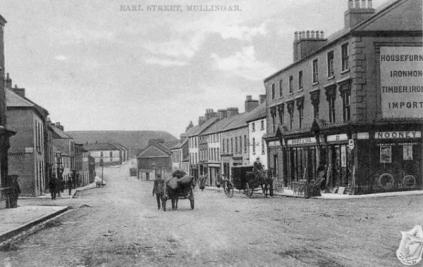
Those who had created the situation seemed less inclined to take responsibility now. Maguire heard that someone from the Mullingar IRA staff was looking for him with intent to ask for the prisoners to be released but he remained unresponsive. After a few days, Moore and Hyde, still blindfolded, were taken to Co. Clare where they were set loose. From there, the freed men made their way to the nearest RIC barracks.
It is unclear how long they had been held; according to Macken, between three or four days, while Maguire thought between eight or ten. However, the actual length of time seems to have been relatively short, as newspaper accounts described them as being released on the 16th after disappearing on the 14th.
Adding to the confusion, the monthly RIC report on the state of the county had Moore and Hyde as being taken on the 13th and released on the 14th, but it almost certainly an error considering the consistency of the newspapers covering the story.
Unfortunately for the Volunteers involved, their unwilling guests had not been idle during their captivity, having covertly cut notches and other marks on the walls of their prison for later identification. Before release, their captors had threatened them with worse should they ever sit on a Bench again. Unfazed, the former detainees were now in a position to turn the tables.[8]
The Arrests
Patrick McCabe was coming out of Castlepollard Chapel after attending Rosary service with a number of others, including Volunteers in his battalion, when they found themselves surrounded. It was a mixed force of police and military of the sort that had been combing the area since the release of the magistrates.
Some of the arrestees were released almost immediately, eight were not. McCabe was one of those held back to be searched. He had the bad luck to be carrying with him on that day a sketch plan of the RIC Barracks in Castlepollard. McCabe was taken with the other prisoners to the same barracks he had been planning on attacking, then transferred to the Mullingar one before being sent to Mountjoy Prison in Dublin, pending the court-martial which would not take place until December.
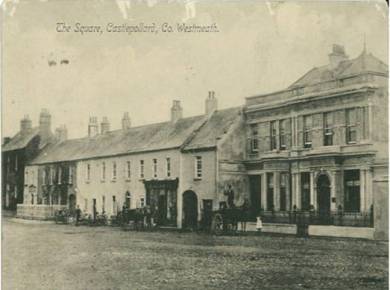
True to form, the prisoners refused to issue pleas or recognise the legitimacy of the Crown court at their hearing. Of the twelve accused of the unlawful conspiracy to assault and imprison Moore and Hyde, eight were found innocent and the other four were not. McCabe was among the latter, though the most he had to do with the conspiracy was to suggest it. He would remain in Perth Prison in England until January 1922 when he was released under the terms of the Truce that ended the War of Independence.[9]
The Fugitive
John Macken had a more convoluted experience with the justice system. Faced with the probability of being arrested, he went on the run, having already had his home in Castlepollard raided by the military.
One night, another search party found the house where he was hiding. Macken had taken the precaution of sleeping in the barn and heard the soldiers threaten the owner of the home and his young son. The boy had the presence of mind to tell his questioners that he had seen the wanted man on his way to Mullingar a few days previously. The search party left, saying they would return; at this point, Macken slipped away to find another bolthole.

After a fortnight as a fugitive, Macken somehow persuaded himself that the authorities would not continue their search during a market day. He thus returned home with the intention of helping his father on the farm, and was in the house when a lorry pulled up at the door. Macken’s first thought was to go through a back window before realising he had already been seen and risked being shot if he tried to flee.
As with McCabe, Macken was taken to Mullingar Barracks before being forwarded to Mountjoy. There he came face to face with his former captive, Moore, on an identification parade. However, Moore’s memory was not as sharp as his survival skills and passed over Macken for someone else who had had nothing to do with his kidnap.
Macken remained in Mountjoy for another three weeks before being released. By that time, he had developed a bad cold and had to stay at home in bed, under the assumption that he would not be arrested again. This was despite warnings to the contrary from Maguire, who obviously had a firmer grasp on the situation.
After four days back in Castlepollard, Macken’s optimism was once again disproved when a Crown patrol arrived to take him back into custody. After a succession of different jails, Macken found himself in the internment camp at Ballykinlar, Co. Down, where he stayed until December 1921 in keeping with the general release of war prisoners.[10]
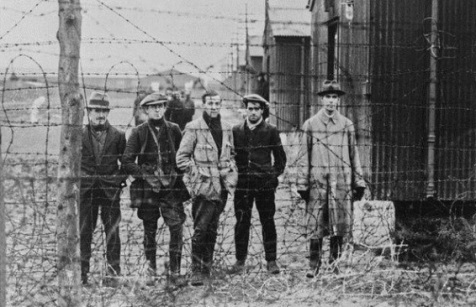
The Remains
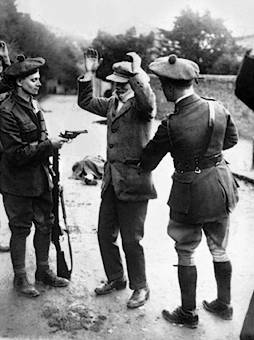 The wholesale round-ups that followed the kidnap and release of the two judicial officials gutted the local IRA. Even by the following year, the ferocity of the official response had not abated: in February 1921, practically all the male inhabitants of the town of Delvin, Co. Westmeath, and those nearby were taken into custody and released with the warning that they would be held responsible for anything untoward that happened in the area.
The wholesale round-ups that followed the kidnap and release of the two judicial officials gutted the local IRA. Even by the following year, the ferocity of the official response had not abated: in February 1921, practically all the male inhabitants of the town of Delvin, Co. Westmeath, and those nearby were taken into custody and released with the warning that they would be held responsible for anything untoward that happened in the area.
One of the three who were not released was James Flynn – unsurprisingly so, given how Maguire remembered him as a “good I.R.A. man.” He was the brother of Michael Flynn, one of those first arrested in connection with the kidnappings. According to a newspaper account, Michael had had no active connection with the IRA, leaving the question of his involvement in the abductions, if any, uncertain.
Unlike McCabe and Macken, Michael never made it out of prison alive, dying of heart failure, aged 32, in Mountjoy on 26th October before he could make it to trial with the rest of the accused. Another brother, Christopher, had identified the body, although in keeping with the family’s Republican outlook, he refused to recognise the inquiry. James had been undeterred by his brother’s lonely death, though he was no more successful at avoiding imprisonment.
Maguire remained at liberty but many of those he knew and trusted were gone, leaving him with the lonesome task of rebuilding the Mullingar command structure from the ground up. At an IRA staff meeting in Mullingar, Maguire found himself promoted by default to command of the four Mullingar companies, or rather, what was left of them.
This was over his objections but it was not as if there were many other options. Despite his reservations, Maguire gave in and accepted. There was nothing else for him to do but try his hardest and hope for the best.[11]
See also: Among the Philistines: Dissent and Reaction in the Mullingar IRA Brigade, 1921
See also: Bloodshed in Mullingar: Civil War Begins in Co. Westmeath, April 1922
References
[1] Westmeath Guardian, 15/10/1920
[2] Daly, David (BMH / WS 1,337), p. 8 ; Reilly, James (BMH / WS 1,593) p. 6, McCabe, Patrick (BMH / WS 1,551), p. 9 ; Flynn, Bartholomew (BMH / WS 1,552), p. 7
[3] O’Meara, Seumas (BHM / WS 1504), pp. 29-30
[4] WG, 22/10/1920 ; Police reports from Dublin Castle records (National Library of Ireland), POS 8552
[5] Maguire, James (BMH / WS 1439), pp. 13-14 ; McCabe, p. 13
[6] Maguire, pp. 14-5 ; Macken, John (BMH / WS 1550), pp. 12-4 ; WG, 15/10/1920 ; 08/04/1921
[7] Maguire, pp. 16-7
[8] Ibid, p 15 ; Macken, pp. 13-4 ; WG, 24/12/1920 ; POS 8552
[9] McCabe, pp. 13-4 ; WG, 12/11/1920, 24/12/1920
[10] Macken, pp. 13-6
[11] WG, 18/02/1921, 29/10/20 ; Maguire, pp. 16-8
Bibliography
Bureau of Military History / Witness Statements
Flynn, Bartholomew, WS 1552
Macken, John, WS 1550
Maguire, James, WS 1439
McCabe, Patrick, WS 1551
O’Meara, Seumas, WS 1504
Reilly, James, WS 1593
Westmeath Guardian
15/10/1920
22/10/1920
29/10/20
12/11/1920
24/12/1920
18/02/1921
08/04/1921
Police reports from Dublin Castle records (National Library of Ireland)
POS 8552
